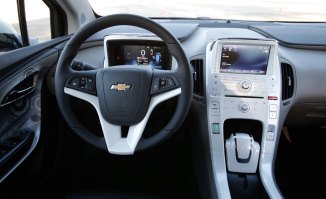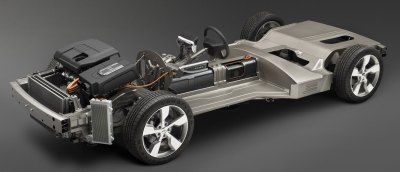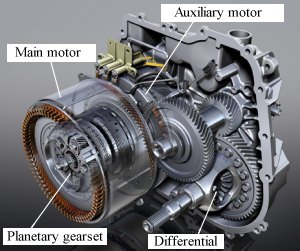Chevrolet Volt
Debut: 2010 |
||||||||||||
In the past couple of years, General Motors was most frequently associated with two words: Bankruptcy and Volt. More interesting, they usually coexisted in the same sentence. The Volt was one of the few projects kept running in full steam during the darkest days of GM. It was the light in the tunnel. It gave hope to GM and, most important, a good excuse for Uncle Sam to bailout the company. Volt has been used as a symbol of the "new GM". Its high-tech, efficient and socially responsible image is what GM wants to project to the whole organization. Ridiculously, Volt is not going to make money during its lifetime. Its substantial development cost is impossible to be recouped by selling only 10,000 copies in 2011 and 45,000 copies annually thereafter as planned by GM. Its production cost – especially those Li-ion batteries and dedicated hybrid power system – are equally staggering, resulting in a price of US$41,000. That is double of a conventional car of this size ! To sweeten the deal, Uncle Sam helps again with a federal incentive of U$7500 per car. Still, its $33,500 net price is difficult to compete with conventional cars, or to less extent Toyota Prius ($23,000 to $28,000 without incentives). Expect technology enthusiasts and environmentalists to be its main supporters.
Externally, the Volt doesn't look as special as Prius, or as futuristic it wants you to believe. Its shape is more or less a conventional C-segment hatchback, just a little more slippery. If not the fake front grille, you can hardly tell it is a plug-in hybrid car. GM tried to inject some sophistication to the design with fancy light graphics and panda-style "eye shadows" below the side windows, though their effect is limited. To add your disappointment, the Volt has a drag coefficient of 0.28, not only poorer than Prius (0.25) but also less slippery than conventional cars like Mercedes E-class (0.25). 14 years ago, GM achieved 0.19 with EV1. Time did not improve its aerodynamics. Inside, the cabin of Volt is far more unconventional. The LCD instruments and milky white center console look as if come from a 1990s Volvo concept car. The console is full of touch-sensitive buttons. Unfortunately, its shiny hard plastic surfaces feel cheap, and the small markings and light reflection make it a nightmare for ergonomics. Rest of the cabin materials are hard grained plastics, hardly match those in a modern supermini, let alone a car at this price. This reflects the downside of its rush to the market and its low production volume. On the upside, both LCD screens on the instrument pod and center console displays well designed graphical information for the hybrid power system, its state of power distribution, battery reserve and estimated mileage etc. They are presented in an interactive way to encourage you to drive as frugally as possible. That said, it's no more attractive than the Powerball of Honda FCX Clarity.
The Volt shares the C-segment Delta platform with Chevrolet Cruze (Daewoo Lacetti) as well as its 2685 mm wheelbase, therefore don't expect Prius level of interior space. Its rear seats are cramped for six-footers, while a prominent transmission tunnel makes it strictly a 4-seater. Luggage utility, however, is good, thanks to a hatchback door, large load bay and fold-flat rear seats. The "transmission tunnel" runs the full length of the cabin because it accommodates a large part of the Lithium-ion batteries. The remaining batteries are situated under the rear seat, forming a letter "T" together with those in central tunnel. Needless to say, placing 200kg of batteries low in the floorpan and within the wheelbase help improving center of gravity and balance of the car. However, part of the balance is offset by the 1.4-liter petrol engine and large electric motors up front, so the Volt is about as nose-heavy as conventional front-wheel drive cars. Moreover, the large batteries and hybrid powertrain also lifted its kerb weight to 1715 kg. That is 335 kg more than Prius ! However, direct comparison with the Toyota hybrid could be unfair because the Volt is a plug-in hybrid. In the Toyota, as well as any other hybrid cars on the market until now, engine is the primary source of power while battery and electric motors work only during low speed cruising, regenerative braking or provide assistance during acceleration. This explain why the Toyota has only a 80hp motor and a 3kWh NiMH battery pack. It can run on purely battery power for only 1 mile, and at a speed no more than 25 mph. In contrast, the Volt has a 149 hp motor and a 16kWh high-performance Li-ion battery. In pure EV mode it can run up to 100 mph and has a range of 25-50 miles (remark: during test drives most journalists achieved 30-40 miles). This mean many people will be able to drive to work and back home without ever firing the engine. To them, Volt is equivalent to a pure electric car. All you need to do is just to plug in the car at your home socket and recharge it overnight. This takes 10 hours on ordinary 120V home socket, or 4 hours on special 240V socket. It goes without saying that electricity bill is a lot cheaper than fuel bill. Also, electricity generation at power plant is far more efficient than burning gasoline or diesel in your cars.
Compare with electric cars, Volt has a strong advantage in range. When its battery runs low, it turns on the 1.4-liter petrol engine, which generates electricity to feed the motor. With a full tank of fuel and full battery, the car has a range of more than 300 miles. Moreover, it can refill at gas stations, so there is no worry of running out of energy like EVs. This sounds simple, but in reality the plug-in hybrid system is quite complicated. It incorporates a 84hp Opel 1.4-liter engine, a 149hp main motor, a 74hp auxiliary motor and a planetary-gear CVT. The main motor is purely for propulsion, whereas the auxiliary motor primarily acts as generator but may also be used as propulsion motor if needed. Both motors are ring-shaped, and their cores are inserted with the planetary gearset so to save space. Both motors may engage or disengage the gearset via clutches. The engine, sits next to the auxiliary motor, uses another clutch to engage the gearset through the auxiliary motor. The control system has 4 modes of operation: 1. EV mode for low speed (up to 70 mph): only the main motor is engaged, so all power comes from the 149hp motor; 2. EV mode for high speed (up to 100 mph): both motors are engaged to provide power. The combined output is still regulated at 149hp, but running two motors at lower rev is more energy efficient than running only the main motor at high rev; 3. Range extending mode for low speed (up to 70 mph): when battery runs low, the engine starts working. It drives the auxiliary motor, which now acts as generator and is decoupled from the gearset, to generate electricity and supply the main traction motor. As a result, the car is powered by the main motor. Of course, the 84hp engine cannot generate enough power to realize the main motor's 149hp output, so this mode works at below 70 mph. However, in case of overtaking or ascending, the combination of engine power and battery reserve may still allow short burst of full power; 4. Range extending mode for high speed (up to 100 mph): all clutches are engaged. This mean the engine is mechanically connected to the gearset via the auxiliary motor. The latter still works as generator to supply the main traction motor. However, the majority output now comes from the engine. Again, momentary release of full power is possible from the combination of engine and battery power. For extended exploit, output should be no more than the engine's 84hp. Still, this is enough to keep up with traffic on highway.
Nevertheless, the fouth mode means Volt is not exactly an "extended range electric vehicle" as GM claimed, because its engine may drive the wheels through mechanical means. A real extended range EV shall have only electrical connection between the engine and the drive system. This caused some debates in the press. Anyway, forget the definitions and principles. The most we care is how the Volt performs in the real world. The answer is quite positive. The Volt is more refined than traditional hybrids like Prius. It is free of engine noise and low on wind and road noise. In EV mode it is as silent as ghost, even under acceleration. In range-extending mode, its engine cuts in imperceptibly and remains quiet unless you push it hard. Moreover, its refinement does not come in the price of performance. With as much as 273 pound-foot of torque available right from idle, it provides a solid stream of acceleration. 0-60 mph is achieved in less than 9 seconds, a full second quicker than Prius. In corners, the car is also more capable than its rival Prius. Its Michelin low-rolling resistance tires are wider and grippier. Its braking is more powerful, despite of its hefty weight. Chassis balance and ride quality are just as good as conventional cars. The brake pedal and steering are not as linear and natural as conventional ones, but still better than the ones you found on Prius. However, no one would confuse the Volt with a driver's car. Will the Volt succeed ? No, it won't. As mentioned before, it is too expensive for a small car and too costly to build, so it will be a money loser throughout its lifetime. However, if GM keeps developing the "Voltec" hybrid system and extend its usage to more vehicles, it may get return on investment some day. Toyota spent 7 years before Prius got profitable. Thanks to fast progressing battery technology and wider public recognition these days, GM may take less time to do so. Overall, the Volt is a brave and respectable effort, if still not a competitve alternative to conventional cars. |
||||||||||||
| The above report was last updated on 3 Nov 2010. All Rights Reserved. |
| Specifications | ||||||||||||||||||||||||||||||||||||||||||||||||||||||||||||||||||||||||||||||||||||||||
|
||||||||||||||||||||||||||||||||||||||||||||||||||||||||||||||||||||||||||||||||||||||||
| Performance
tested by: *C&D, **MT |
Copyright©
1997-2010
by Mark Wan @ AutoZine






